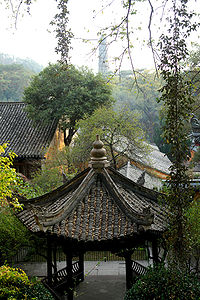
Guoqing Temple
Encyclopedia

Temple
A temple is a structure reserved for religious or spiritual activities, such as prayer and sacrifice, or analogous rites. A templum constituted a sacred precinct as defined by a priest, or augur. It has the same root as the word "template," a plan in preparation of the building that was marked out...
on Mount Tiantai, Zhejiang Province, People's Republic of China. Originally built in 598 AD during the Sui Dynasty
Sui Dynasty
The Sui Dynasty was a powerful, but short-lived Imperial Chinese dynasty. Preceded by the Southern and Northern Dynasties, it ended nearly four centuries of division between rival regimes. It was followed by the Tang Dynasty....
, and renovated during the reign of the Qing
Qing Dynasty
The Qing Dynasty was the last dynasty of China, ruling from 1644 to 1912 with a brief, abortive restoration in 1917. It was preceded by the Ming Dynasty and followed by the Republic of China....
Yongzheng Emperor
Yongzheng Emperor
The Yongzheng Emperor , born Yinzhen , was the fifth emperor of the Manchu Qing Dynasty and the third Qing emperor from 1722 to 1735. A hard-working ruler, Yongzheng's main goal was to create an effective government at minimal expense. Like his father, the Kangxi Emperor, Yongzheng used military...
(r. 1722–1735 AD), the temple is located roughly 220 kilometres (136.7 mi) from the city of Hangzhou
Hangzhou
Hangzhou , formerly transliterated as Hangchow, is the capital and largest city of Zhejiang Province in Eastern China. Governed as a sub-provincial city, and as of 2010, its entire administrative division or prefecture had a registered population of 8.7 million people...
. It was the initial site for the creation of the Tiantai
Tiantai
Tiantai is an important school of Buddhism in China, Japan, Korea, and Vietnam. In Japan the school is known as Tendai, and in Korea it is known as Cheontae. Tiantai is also called the "Lotus School", due to its emphasis on the Lotus Sūtra as its doctrinal basis...
Mahayana
Mahayana
Mahāyāna is one of the two main existing branches of Buddhism and a term for classification of Buddhist philosophies and practice...
Buddhist school, founded by Zhiyi
Zhiyi
Zhiyi is traditionally listed as the fourth patriarch, but is generally considered the founder of the Tiantai tradition of Buddhism in China. His standard title was Śramaṇa Zhiyi , linking him to the broad tradition of Indian asceticism...
(538–597 AD). The temple covers an area of some 23000 square metres (27,507.8 sq yd) and features 600 rooms in a total of 14 different halls, including the Grand Hall of Sakyamuni, the Hall of Five Hundred Arhats and the Hall of Monk Jigong. The exterior of the building features Chinese pagoda
Chinese pagoda
Chinese Pagodas are a traditional part of Chinese architecture. In addition to religious use, since ancient times Chinese pagodas have been praised for the spectacular views which they offer, and many famous poems in Chinese history attest to the joy of scaling pagodas.-History:The pagoda is...
s such as the Sui Pagoda, the Seven Buddha Pagoda, and the Memorial Pagoda of Monk Yi Xing
Yi Xing
Yi Xing , born Zhang Sui , was a Chinese astronomer, mathematician, mechanical engineer,and Buddhist monk of the Tang Dynasty...
(683–727 AD).
Significance
This mountain temple is the site where indigenous Chinese Buddhism branched away from Buddhist teachings and doctrine commonly found in IndiaIndia
India , officially the Republic of India , is a country in South Asia. It is the seventh-largest country by geographical area, the second-most populous country with over 1.2 billion people, and the most populous democracy in the world...
. From there, the Tiantai sect of Buddhism spread to both Korea and Japan during the Tang Dynasty
Tang Dynasty
The Tang Dynasty was an imperial dynasty of China preceded by the Sui Dynasty and followed by the Five Dynasties and Ten Kingdoms Period. It was founded by the Li family, who seized power during the decline and collapse of the Sui Empire...
(618–907 AD). The tall brick Guoqing Pagoda built at the temple in the year 597 AD is still standing, making it one of the oldest surviving brick pagodas in China (after the 40 metres (131.2 ft) tall Chinese Songyue Pagoda
Songyue Pagoda
The Songyue Pagoda , constructed in 523 AD, is located at the Songyue Monastery on Mount Song, in Henan province, China. Built during the Northern Wei Dynasty, this pagoda is one of the few intact sixth-century pagodas in China and is also the earliest known Chinese brick pagoda...
built in 523 AD).
Further reading
- Steinhardt, Nancy Shatzman. "The Tangut Royal Tombs near Yinchuan," Muqarnas: An Annual on Islamic Art and Architecture (Volume X, 1993): 369-381.

